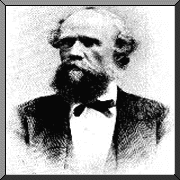 Joseph
LeConte was born in Georgia in 1823. He earned his Doctor
of Medicine degree in New York and set up a practice in Georgia. But
soon thereafter, he discovered a stronger desire to teach, research,
and explore the field of geology than to pursue medicine. So he
switched his career, studied geology at Harvard, and taught at the
University of Georgia.
Joseph
LeConte was born in Georgia in 1823. He earned his Doctor
of Medicine degree in New York and set up a practice in Georgia. But
soon thereafter, he discovered a stronger desire to teach, research,
and explore the field of geology than to pursue medicine. So he
switched his career, studied geology at Harvard, and taught at the
University of Georgia.
He continued teaching during the Civil War, but after the War, he and his brother moved to California where he helped organize the University of California. In 1889, Joseph hooked up with John Muir and a group of people at University of California. They set off for a five week horseback trip to the Yosemite Valley and the High Sierras. This group, today named the Sierra Club, started a campaign to establish today's Yosemite National Park and to promote more recreational uses of the Sierras.
In 1897, Joseph was elected to the National Academy of Sciences. Among LeConte's publications are: A Journal of Ramblings Through the High Sierra, Elements of Geology, The General Interior Condition of the Earth, The Relation of Philosophy to Psychology, Manual of Arms for the Percussion Musket, and The Relation of Evolution to Religious Thought.
In 1901, Joseph died, coincidentally in Yosemite during one of the Club's High Trips. As geologist, naturalist, and university professor, LeConte was an inspiration to those who enjoyed and explored the mountain regions of the Pacific Coast.
Designed by: Nan Bowman
Cohen, M. (1988). The History of the Sierra Club; 1982-1910, Sierra Club Books
Jones, W.R. (1989). Yosemite: The Story Behind the Scenery. Las Vegas, NV: KC Publications.
Muir, J. (1988). Yosemite. Maryland: Random House
Perry, J., Perry, J.G., & Sierra Club (1997). The Sierra Club Guide to the Natural Areas of California. San Francisco, CA: Sierra Club Books.
Sierra Club (1997). Sierra Club--Joseph LeConte. (Online) Available: http://www.sierraclub.org/history/leconte.
University of California Magazine (1901). Reminiscences of Joseph LeConte (Online) Available: http://www.sierraclub.org/history/leconte/tributte.html.